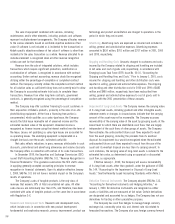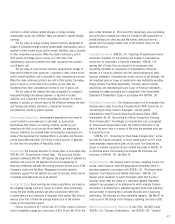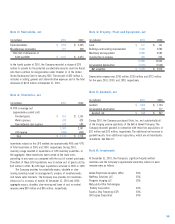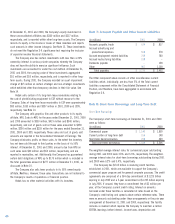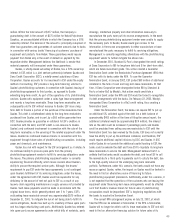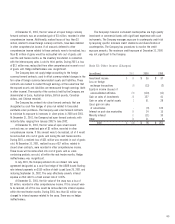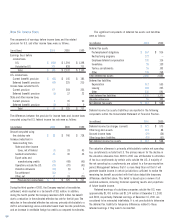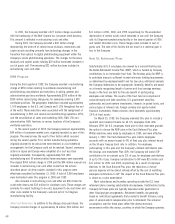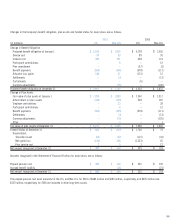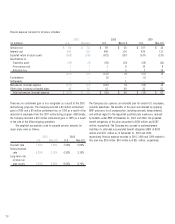Kodak 2001 Annual Report Download - page 66
Download and view the complete annual report
Please find page 66 of the 2001 Kodak annual report below. You can navigate through the pages in the report by either clicking on the pages listed below, or by using the keyword search tool below to find specific information within the annual report.
64
photofinishing equipment. Under the partnership agreement between
Qualex and DCC, subject to certain conditions, ESF has exclusivity rights
to purchase Qualex’s long-term lease receivables. The term of the
partnership agreement continues through October 6, 2003. In light of the
Termination Event referred to above and the timing of the partnership
termination, Qualex is currently considering alternative financing
solutions for prospective leasing activity with its customers.
At December 31, 2001, the Company had outstanding letters of
credit totaling $42 million and surety bonds in the amount of $94 million
to ensure the completion of environmental remediations and payment of
possible casualty and workers’ compensation claims.
Rental expense, net of minor sublease income, amounted to $126
million in 2001, $155 million in 2000 and $142 million in 1999. The
approximate amounts of noncancelable lease commitments with terms of
more than one year, principally for the rental of real property, reduced by
minor sublease income, are $106 million in 2002, $85 million in 2003,
$70 million in 2004, $36 million in 2005, $25 million in 2006 and $45
million in 2007 and thereafter.
The Company and its subsidiary companies are involved in lawsuits,
claims, investigations and proceedings, including product liability,
commercial, environmental, and health and safety matters, which are
being handled and defended in the ordinary course of business. There are
no such matters pending that the Company and its General Counsel
expect to be material in relation to the Company’s business, financial
position or results of operations.
Note 11: Financial Instruments
The following table presents the carrying amounts of the assets
(liabilities) and the estimated fair values of financial instruments at
December 31, 2001 and 2000:
2001 2000
Carrying Fair Carrying Fair
(in millions) Amount Value Amount Value
Marketable
securities:
Current $3$3$5$5
Long-term 34 34 54 53
Other
investments ––22
Long-term debt (1,666) (1,664) (1,166) (1,184)
Foreign currency
forwards 11(44) (44)
Silver forwards 11(17) (17)
Interest rate swap (2) (2) ––
Marketable securities and other investments are valued at quoted market
prices. The fair values of long-term borrowings are determined by
reference to quoted market prices or by obtaining quotes from dealers.
The fair values for the remaining financial instruments in the above
table are based on dealer quotes and reflect the estimated amounts the
Company would pay or receive to terminate the contracts. The carrying
values of cash and cash equivalents, receivables, short-term borrowings
and payables approximate their fair values.
The Company, as a result of its global operating and financing
activities, is exposed to changes in foreign currency exchange rates,
commodity prices, and interest rates which may adversely affect its
results of operations and financial position. The Company manages such
exposures, in part, with derivative financial instruments. The fair value of
these derivative contracts is reported in other current assets or accounts
payable and other current liabilities.
Foreign currency forward contracts are used to hedge existing
foreign currency denominated assets and liabilities, especially those of
the Company’s International Treasury Center, as well as forecasted
foreign currency denominated intercompany sales. Silver forward
contracts are used to mitigate the Company’s risk to fluctuating silver
prices. The Company’s exposure to changes in interest rates results from
its investing and borrowing activities used to meet its liquidity needs.
Long-term debt is generally used to finance long-term investments, while
short-term debt is used to meet working capital requirements. An interest
rate swap agreement was used to convert some floating-rate debt to
fixed-rate debt. The Company does not utilize financial instruments for
trading or other speculative purposes.
On January 1, 2000, the Company adopted SFAS No. 133,
“Accounting for Derivative Instruments and Hedging Activities.” This
statement requires that an entity recognize all derivatives as either
assets or liabilities and measure those instruments at fair value. If
certain conditions are met, a derivative may be designated as a hedge.
The accounting for changes in the fair value of a derivative depends on
the intended use of the derivative and the resulting designation.
The transition adjustment was a loss of $1 million recorded in other
income (charges) for marking foreign exchange forward contracts to fair
value, and an unrealized gain of $3 million recorded in other
comprehensive income for marking silver forward contracts to fair value.
These items were not displayed in separate captions as cumulative
effects of a change in accounting principle, due to their immateriality.
The fair value of the contracts is reported in other current assets or in
current liabilities.
The Company has entered into foreign currency forward contracts
that are designated as cash flow hedges of exchange rate risk related to
forecasted foreign currency denominated intercompany sales. At
December 31, 2001, the Company had cash flow hedges for the Euro, the
Canadian dollar, the Australian dollar, and the Korean won, with maturity
dates ranging from January 2002 to July 2002.




